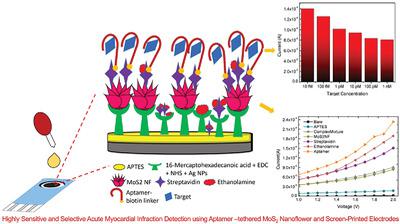当前位置:
X-MOL 学术
›
Biotechnol. Appl. Bioc.
›
论文详情
Our official English website, www.x-mol.net, welcomes your
feedback! (Note: you will need to create a separate account there.)
Highly sensitive and selective acute myocardial infarction detection using aptamer-tethered MoS2 nanoflower and screen-printed electrodes
Biotechnology and Applied Biochemistry ( IF 3.2 ) Pub Date : 2020-11-02 , DOI: 10.1002/bab.2060 Mugashini Vasudevan 1, 2 , Melvin J Y Tai 1, 2 , Veeradasan Perumal 1, 2 , Subash C B Gopinath 3, 4 , Satisvar Sundera Murthe 1, 5 , Mark Ovinis 2 , Norani Muti Mohamed 1, 5 , Nirav Joshi 6, 7
Biotechnology and Applied Biochemistry ( IF 3.2 ) Pub Date : 2020-11-02 , DOI: 10.1002/bab.2060 Mugashini Vasudevan 1, 2 , Melvin J Y Tai 1, 2 , Veeradasan Perumal 1, 2 , Subash C B Gopinath 3, 4 , Satisvar Sundera Murthe 1, 5 , Mark Ovinis 2 , Norani Muti Mohamed 1, 5 , Nirav Joshi 6, 7
Affiliation

|
Acute myocardial infarction (AMI) is one of the leading causes of death worldwide. Cardiac troponin I (cTn1) is a commonly used biomarker for the diagnosis of AMI. Although there are various detection methods for the rapid detection of cTn1 such as optical, electrochemical, and acoustic techniques, electrochemical aptasensing techniques are commonly used because of their ease of handling, portability, and compactness. In this study, an electrochemical cTn1 biosensor, MoS2 nanoflowers on screen-printed electrodes assisted by aptamer, was synthesized using hydrothermal technique. Field emission scanning electron microscopy revealed distinct 2D nanosheets and jagged flower-like 3D MoS2 nanoflower structure, with X-ray diffraction analysis revealing well-stacked MoS2 layers. Voltammetry aptasensing of cTn1 ranges from 10 fM to 1 nM, with a detection limit at 10 fM and a sensitivity of 0.10 nA µM−1 cm−2. This is a ∼fivefold improvement in selectivity compared with the other proteins and human serum. This novel aptasensor retained 90% of its biosensing activity after 6 weeks with a 4.3% RSD and is a promising high-performance biosensor for detecting cTn1.
中文翻译:

使用适配体连接的 MoS2 纳米花和丝网印刷电极进行高灵敏度和选择性的急性心肌梗死检测
急性心肌梗死 (AMI) 是全球主要的死亡原因之一。心肌肌钙蛋白 I (cTn1) 是诊断 AMI 的常用生物标志物。尽管有多种检测方法可用于快速检测 cTn1,如光学、电化学和声学技术,但电化学适体传感技术因其易于处理、便携和紧凑而被普遍使用。在这项研究中,采用水热技术合成了一种电化学 cTn1 生物传感器,即在适体辅助的丝网印刷电极上的 MoS 2纳米花。场发射扫描电子显微镜显示不同的 2D 纳米片和锯齿状花状 3D MoS 2纳米花结构,X 射线衍射分析显示堆叠良好的 MoS 2 层。cTn1 的伏安法适配感应范围为 10 fM 至 1 nM,检测限为 10 fM,灵敏度为 0.10 nA µM -1 cm -2。与其他蛋白质和人血清相比,这在选择性上提高了约五倍。这种新型适体传感器在 6 周后保留了 90% 的生物传感活性,RSD 为 4.3%,是一种用于检测 cTn1 的有前途的高性能生物传感器。
更新日期:2020-11-02
中文翻译:

使用适配体连接的 MoS2 纳米花和丝网印刷电极进行高灵敏度和选择性的急性心肌梗死检测
急性心肌梗死 (AMI) 是全球主要的死亡原因之一。心肌肌钙蛋白 I (cTn1) 是诊断 AMI 的常用生物标志物。尽管有多种检测方法可用于快速检测 cTn1,如光学、电化学和声学技术,但电化学适体传感技术因其易于处理、便携和紧凑而被普遍使用。在这项研究中,采用水热技术合成了一种电化学 cTn1 生物传感器,即在适体辅助的丝网印刷电极上的 MoS 2纳米花。场发射扫描电子显微镜显示不同的 2D 纳米片和锯齿状花状 3D MoS 2纳米花结构,X 射线衍射分析显示堆叠良好的 MoS 2 层。cTn1 的伏安法适配感应范围为 10 fM 至 1 nM,检测限为 10 fM,灵敏度为 0.10 nA µM -1 cm -2。与其他蛋白质和人血清相比,这在选择性上提高了约五倍。这种新型适体传感器在 6 周后保留了 90% 的生物传感活性,RSD 为 4.3%,是一种用于检测 cTn1 的有前途的高性能生物传感器。









































 京公网安备 11010802027423号
京公网安备 11010802027423号